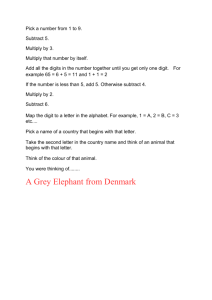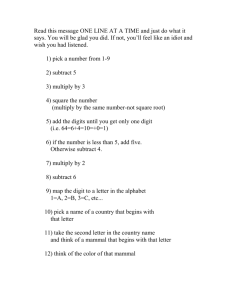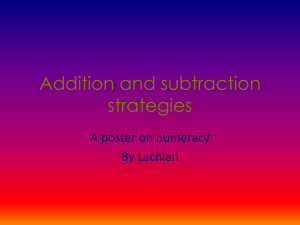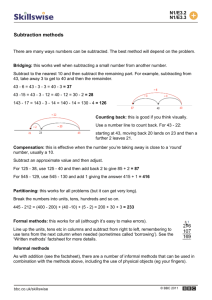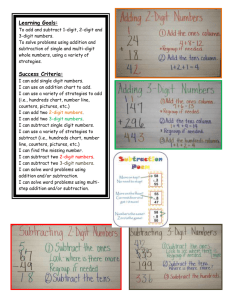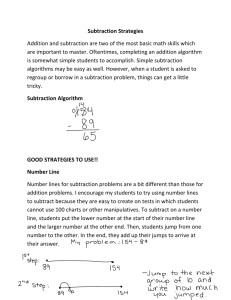Module 1 Lesson 15 Place Value, Rounding, and Algorithms for
advertisement
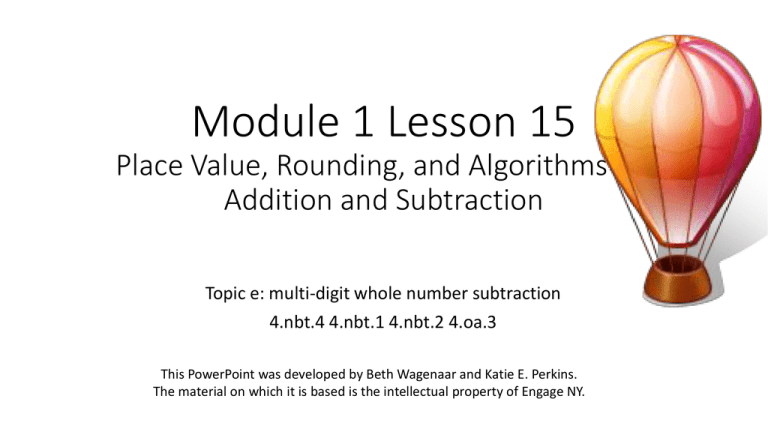
Module 1 Lesson 15 Place Value, Rounding, and Algorithms for Addition and Subtraction Topic e: multi-digit whole number subtraction 4.nbt.4 4.nbt.1 4.nbt.2 4.oa.3 This PowerPoint was developed by Beth Wagenaar and Katie E. Perkins. The material on which it is based is the intellectual property of Engage NY. Lesson 15 Topic: Multi-digit whole number subtraction • Objective: Use place value understanding to fluently decompose to smaller units multiple times in any place using the standard subtraction algorithm, and apply the algorithm to solve word problems using tape diagrams. Lesson 15 Place Value Fluency 3 Minutes 4,598 Say the number. What Is the value of the 9? State the value of the digit 5. What digit is in the tens place? State the value of the digit 4. Lesson 15 Place Value Fluency 3 Minutes 69,708 Say the number. What Is the value of the 9? State the value of the digit 7. State the value of the digit 6. What digit is in the tens place? Lesson 15 Place Value Fluency 3 Minutes 398,504 Say the number. What Is the value of the 9? State the value of the digit 3. State the value of the digit 5. What digit is in the tens place? Lesson 15 Place Value Fluency 3 Minutes Say the number. 8,253,967 What Is the value of the 9? State the value of the digit 3. State the value of the digit 8. What digit is in the tens place? Find the Difference 4 Minutes 4,625 – 815 = 846 - 304 = 8,056 – 5,004 = 45,836 – 2,906 = 935 - 17 = Lesson 15 Convert Units Lesson 15 4 Minutes • Count by 20 centimeters. When you get to 100 centimeters, say 1 meter. Repeat until you get to 300 centimeters, or 3 meters. 2 Meter 3 Meters Convert Units Lesson 15 4 Minutes 175 cm = ____ m ___ cm 130 cm = __ m__ cm 345 cm = _____ m ___cm 103 cm = ___ m ____ cm 708 cm = ____ m ___ cm 725 cm = ____m ____ cm Lesson 15 Application Problem 5 Minutes When the amusement park opened, the number on the counter at the gate read 928,614. At the end of the day, the counter read 931,682. How many people went through the gate that day? You may choose which strategy you use to find the solution! Lesson 15 Concept Development 32 Minutes Materials: Personal white boards, place value charts Problem 1 Lesson 15 253,421 Regroup units 5 times to subtract. 253,421 - 75,832 75,832 A • Say this problem with me. • Work with your partner to draw a tape diagram representing this problem. Work Space: Problem 1 Lesson 15 253,421 Regroup units 5 times to subtract. 253,421 - 75,832 75,832 A • What is the whole amount? • What part are we separating out? • Look across the top number, 253,421, to see if we have enough units in each column to subtract 75,832. Are we ready to subtract? • Is the number of units in the top number of the ones column greater than or equal to that of the bottom number? I will regroup in the work space. Work Space: Problem 1 Lesson 15 253,421 Regroup units 5 times to subtract. 253,421 - 75,832 75,832 A • What should we do? I will regroup in the work space. • The tens column is ready to subtract. • Is the number of units in the top number of the hundreds column greater than or equal to that of the bottom number? Work Space: Problem 1 Lesson 15 253,421 Regroup units 5 times to subtract. 253,421 - 75,832 75,832 A • What should we do? I will regroup in the work sace.Go ahead and subtract! • The hundreds column is now ready to subtract. State the difference to your partner. • Is the number of units in the top number of the thousands column greater Label the missing part than or equal to that of the bottom number? in your tape diagram. • Continue questioning if the top number is greater than or equal to the bottom unit across all units, regrouping where needed. Problem 2 1,000,000 1,000,000 – 345,528 • Read this problem and draw a tape diagram to represent the subtraction problem. • Record the problem on your board. • What do you notice when you look across the top number? • You are right! There are many more zeros. We will have to regroup 6 times! • Work with your partner to get 1,000,000 ready to subtract. • Rename your units in the subtraction problem. Millions Hundred Thousands Ten Thousands 9 hundred thousands 9 ten thousands Thousands 1,000,000 - 345,528 Hundreds Tens Ones l 9 thousands 9 hundreds 9 tens 10 ones 345,528 Lesson 15 a Are we ready to subtract? Get to work! To check your answer, add the parts to see if you get the correct whole amount! Lesson 15 Problem 3 Solve a word problem decomposing units multiple times. Last year, there were 620,073 people in attendance at a local parade. This year, there were 456,795 people in attendance. How many more people were in attendance last year? Lesson 15 Last year, there were 620,073 people in attendance at a local parade. This year, there were 456,795 people in attendance. How many more people were in attendance last year? 620,073 456,795 a Problem 3 Cont. • Represent this information in a tape diagram. • Work with your partner to write a subtraction problem using the information in the tape diagram • Look across the top number to see if the units in the top number are greater than or equal to that of the bottom number. Are you ready to subtract? • You observed that you need to unbundle 1 ten to make 10 ones. • Continue to check if you are ready to subtract in each column. • When you are ready to subtract, solve. • 620,073 minus 456,795 equals 163,278. • There were 163,278 more people in attendance than last year. 620,073 -456,795 Problem Set (10 Minutes) Lesson 15 Lesson 15 Lesson 15 Lesson 15 Lesson 15 • Problem 1(e) and 1(f) were similar. Did anyone notice a pattern that could be used to solve this problem? • How did your tape diagrams differ in Problems 2, 3, and 4? • How do you know when you are ready to subtract across the algorithm? • How can you check your answer when subtracting? • Is there a number that you can subtract from 1,000,000 without decomposing across to the ones (other than 1,000,000)? 100,000? 10,000? • How can decomposing multiple times be challenging? • How does the tape diagram help you determine which operation to use to find the answer? Student Debrief Lesson 15 11 minutes Objective: Use place value understanding to fluently decompose to smaller units multiple times in any place using the standard subtraction algorithm, and apply the algorithm to solve word problems using tape diagrams. Exit Ticket Lesson 15 Lesson 15 Lesson 15 Lesson 15 Lesson 15 Lesson 15 Lesson 15
